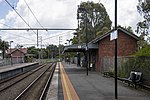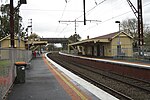Clifton Hill railway station
Heritage-listed buildings in MelbourneListed railway stations in AustraliaPremium Melbourne railway stationsRailway stations in Australia opened in 1888Railway stations in Melbourne ... and 2 more
Use Australian English from February 2015Victorian Heritage Register

Clifton Hill railway station is the junction station for the Mernda and Hurstbridge lines in Victoria, Australia. It serves the north-eastern Melbourne suburb of Clifton Hill, and it opened on 8 May 1888.Immediately to the north of the station, the Mernda and Hurstbridge lines diverge.
Excerpt from the Wikipedia article Clifton Hill railway station (License: CC BY-SA 3.0, Authors, Images).Clifton Hill railway station
Hoddle Street, Melbourne Clifton Hill
Geographical coordinates (GPS) Address External links Nearby Places Show on map
Geographical coordinates (GPS)
| Latitude | Longitude |
|---|---|
| N -37.7887 ° | E 144.9954 ° |
Address
Clifton Hill
Hoddle Street
3070 Melbourne, Clifton Hill
Victoria, Australia
Open on Google Maps







